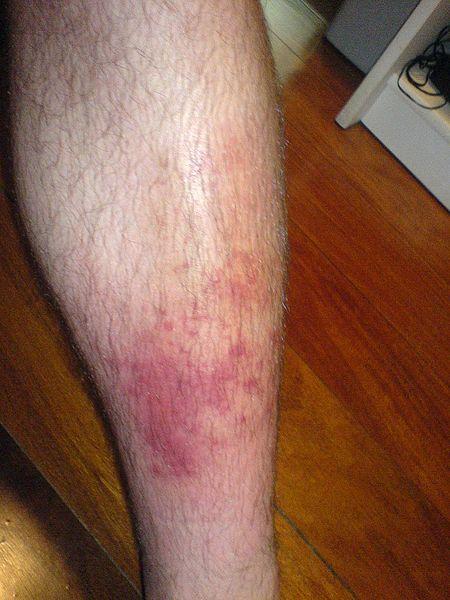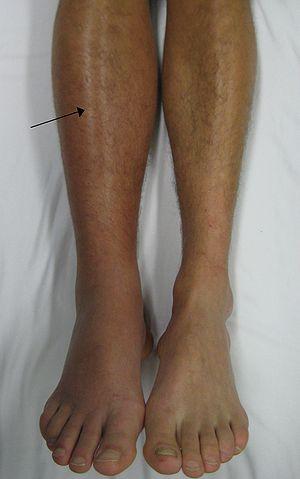Swollen Calf Muscles – Causes of Swelling of Back of Lower Leg
What is a swollen calf?
A swollen calf is swelling at the back of the lower leg. It may occur with swelling of the feet and ankles and broadly referred to as a swollen leg. However, sometimes calf swelling occurs on its own with little or no swelling of the feet and ankles. While there are specific causes for this localized swelling, particularly when only the back of the leg (calf) is swollen, the feet and ankles often become swollen shortly afterwards. This is because many of the causes of calf swelling involve the veins or lymphatic vessels which not only drains the calf and shin but also the feet and ankles.
A swollen calf is a symptom of some localized problem within the lower leg (between the ankle and knee) and can be present with other symptoms such as redness of the skin, lower leg pain, leg numbness or other abnormal sensations and/or weak legs. The collection of symptoms together may be indicative of the cause and calf swelling on it own is non-specific meaning that it does clearly indicate an exact condition.
What is in the back of the lower leg?
It is important to understand structures that lie in the back of the lower leg which can lead to calf swelling when injured or diseased. The lower leg itself, referring to the area between the ankle and knee, is composed mainly of muscles lying around two thin but very strong long bones known as the tibia and fibula.
These muscles are divided by thick sheets of connective tissue (fascia) into four compartments :
- Anterior compartment at the front of the leg or shin.
- Lateral compartment at the outer side of the leg.
- Two posterior compartments at the back of the leg – a superficial and deep compartment.
The superficial posterior compartment contains the the gastrocnemius and soleus muscles. These are commonly referred to as the calf muscles because it is easily visible and palpable (can be felt). The deep compartment contains the popliteus, tibialis posterior, flexor digitorum longus, and flexor hallucus longus muscles. Apart from moving the lower leg and feet, these muscles also act as a pump to push blood in the veins of the lower leg back to the heart.
Other important structures running through the back of the leg which are relevant to calf swelling includes the superficial and deep veins of the leg. These leg veins have valves which helps prevent the backward flow of blood as it travels from the leg to the heart. It is also the site of two common circulation problems of the leg – varicose veins (superficial veins) and deep vein thrombosis (deep veins). The arteries and nerves within the lower leg are unlikely to present with calf swelling when injured or diseased.
Causes of Calf Swelling
A swollen calf may arise as a sign of inflammation following injury to one or more structures of the leg. Inflammation is a protective mechanism in the body to limit the damage to an area. It is also accompanied by pain with warmth and redness of the skin if it is superficial. Another fairly common cause is related to fluid accumulation within the leg, whether due to blood congestion or tissue fluid. Normally blood and tissue fluid is drained away by the veins and lymphatic vessels respectively. Any disorder with these structures will therefore lead to blood or tissue fluid accumulation in the calf.
Injury and Overuse
Injury of any of the leg structures is a leading cause of acute inflammation and swelling. With the leg muscles and tendons, overuse may also cause inflammation. Swelling of the more superficial muscles at the back of the lower leg – gastrocnemius or soleus – is more likely to contribute to visible swelling. However, inflammation of the deep posterior compartment and lateral compartment muscles may also be responsible for a swollen calf. The concern with muscle swelling is that it may give rise to compartment syndrome. Causes of swelling includes :
- Blunt or sharp force injury to the leg
- Fractured bones
- Muscle strain and tendonitis
- Torn calf muscle
- Phlebitis – vein inflammation following injury.
- Surgery to the leg
- Compression of the leg

Compartment Syndrome
The different compartments of the leg are formed by the fascia. This thick connective tissue does not expand easily and any swelling within the compartment compresses the tissue within it. Compression of the blood vessels severely compromises circulation and nerve compression may lead to pain, numbness or paralysis. This is known as compartment syndrome. The causes of acute compartment syndrome are largely the same as those of injury and overuse. Chronic or exertional compartment syndrome is more likely to arise in professional athletes who are constantly in training.
Infection
An infection of the lower leg is most of the time bacterial in nature. It can arise with a penetrating skin injury that allows the bacteria to enter the deeper tissue. Less commonly the microbes may travel via the bloodstream from a distant site to the leg. Infections of the leg are more likely to arise after trauma, in a person with a weakened immune system, diabetics, with circulatory problems of the legs and leg ulcers. This can include :
- Infections of the skin like the erysipelas, impetigo and staphylococcal skin infections.
- Cellulitis which involves the tissue lying just under the skin (subcutaneous tissue).
- Osteomyelitis is an infection of the bone.
- Septic thrombophlebitis is an infection of the vein.

Blood Vessels
Several problems can arise with the blood vessels of the legs. Vein problems are more likely to cause swelling of the calf. It may be isolated to superficial veins of the lower legs, deep veins or affect the entire venous system.
- Deep vein thrombosis (DVT) is the formation of a clot of clots in the deep veins of the lower leg.
- Varicose veins is the dilation and twisting of the superficial veins of the leg.
- Phlebitis is inflammation of the veins.
These conditions contribute to venous insufficiency of the legs which is the inadequate drainage of blood in the lower leg. As blood pools in the leg (venous stasis), it gives rise to symptoms such as swelling, purple to brown darkening of the skin, itching and venous ulcers on the leg.

Peripheral Edema
Edema is accumulation of fluid within the tissue spaces between the cells and within the cells itself to some degree. It is referred to as peripheral edema since it more commonly occurs in the feet, ankles and lower legs. Edema is a result of excessive fluid accumulating in the tissue spaces or inadequate drainage of the additional tissue fluid through the lymphatic system. It may present as pitting or non-pitting edema depending on the cause. It is uncommon for peripheral edema to occur only in the calf without involving the feet and ankles. Possible causes include :
- Kidney disease where the electrolyte and water balance is disrupted leading to water retention.
- Heart failure where the heart cannot adequately pump blood throughout the body.
- Liver disease increases pressure in the veins and causes a reduction in the blood protein albumin both of which contribute to fluid accumulation.
- Lymphangitis is inflammation of the lymphatic vessels which impairs the drainage of the excess tissue fluid from the legs.
- Leg vein problems which apart from causing congestion of the blood in the legs also prevents tissue fluid from draining out and forces fluid from the vein into the tissue spaces.
Last updated on September 7, 2018.





